My new Horror Thursday column is up at Man, I Love Films. This week, we’re diving into the M. Night Shyamalan film that was cleverly marketed as not an M. Night Shyamalan film to quell the revolt before it started.
Horror Thursday: Devil
My new Horror Thursday column is up at Man, I Love Films. This week, we’re diving into the M. Night Shyamalan film that was cleverly marketed as not an M. Night Shyamalan film to quell the revolt before it started.
Horror Thursday: Devil
This week on Sketchy Details @Home, we play along with the comedy poltergeist challenge of SyFy’s Face Off. The results on this challenge were really good overall. The judges hated the design I used for my inspiration, Laney’s punk rocker electrocuted during a concert, but it was my favorite design by far. She aimed for a living Monster High doll and nailed it.
My take is a cool Halloween project inspired by some random photo I saw when prepping for Halloween last year. It’s a translucent, very stable packing tape ghost. I upped my game by building up the wig head base with a custom carved hairdo that meant building it as one piece and dissecting it afterwards for the final presentation. Watch then click through for the behind the scenes.
This is the beginning of a bizarre experiment in surrealism and video games agency (how collective choices influence a game) from Galactic Cafe. The game is all about choice. The framework always goes narrator’s choice or other option. Move on as instructed or go off the path. The further you wander, the stranger the game becomes.
On my first playthrough (the scenarios vary in length, but it’s only a few minutes from beginning to restart), for example, I caused the total nuclear annihilation of my little world at work. That happened because of one anti-narrator choice. To call that a jarring start to a gaming experience is an understatement. Yet I was sucked right into this bizarre world because the creators went that far.
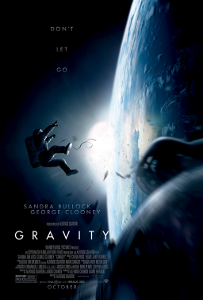 Lieutenant Matt Kowalski is in charge of a five-person mission to the Hubble Space Telescope to install Dr. Ryan Stone’s new monitoring equipment. Everything is going fine until mission control announces that a Russian satellite has blown up and the debris may be heading their way. That is quickly upgraded to abandon the Hubble and flee the scene to stay alive, which is promptly followed by Kowalski and Stone drifting in space in radio silence, the only survivors of a routine maintenance mission to space gone horribly wrong.
Lieutenant Matt Kowalski is in charge of a five-person mission to the Hubble Space Telescope to install Dr. Ryan Stone’s new monitoring equipment. Everything is going fine until mission control announces that a Russian satellite has blown up and the debris may be heading their way. That is quickly upgraded to abandon the Hubble and flee the scene to stay alive, which is promptly followed by Kowalski and Stone drifting in space in radio silence, the only survivors of a routine maintenance mission to space gone horribly wrong.
Alfonso Cuarón has crafted his true masterpiece in Gravity. George Clooney and Sandra Bullock create believable characters in Kowalksi and Stone, but it is Cuarón who is the star of the production. Everything is about a deft director handling his own screenplay (written with his son Jonás Cuarón) with incredible style and urgency.
Five time Academy Award-nominated cinematographer Emmanuel Lubezki (The Tree of Life, Children of Men) helps create some of the finest moments of 3D cinema ever projected on a screen. If nothing else, Gravity evokes its haunting terror by showcasing just how vast space is. The screen falls back for hundreds, if not thousands, of miles to sell the narrative of two astronauts drifting through space with only the slightest chance of survival.
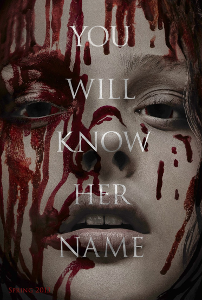 Director Kimberly Peirce and screenwriter Roberto Aguirre-Sacasa (Spider-Man: Turn Off the Dark) seem to be at odds over how to handle a Carrie remake. Peirce coaxes a very natural, almost underplayed, beauty from her cast of actors. She downplays the infamous abuse in the White household to turn Carrie into a Greek-style tragedy, with the massive punishment of The Destruction and the catharsis of the final moments. Aguirre-Sacasa lifts most of his screenplay wholesale from the (rightfully credited) Lawrence D. Cohen version and adds in a few cool details from the Stephen King novel. His biggest contribution is finding a brilliant throughline in social media and the pervasiveness of technology when it comes to bullying in modern high schools. Aguirre-Sacasa’s laser vision on the literal text of Carrie gives Peirce the freedom to mold it into biting social commentary through performance and technical craft.
Director Kimberly Peirce and screenwriter Roberto Aguirre-Sacasa (Spider-Man: Turn Off the Dark) seem to be at odds over how to handle a Carrie remake. Peirce coaxes a very natural, almost underplayed, beauty from her cast of actors. She downplays the infamous abuse in the White household to turn Carrie into a Greek-style tragedy, with the massive punishment of The Destruction and the catharsis of the final moments. Aguirre-Sacasa lifts most of his screenplay wholesale from the (rightfully credited) Lawrence D. Cohen version and adds in a few cool details from the Stephen King novel. His biggest contribution is finding a brilliant throughline in social media and the pervasiveness of technology when it comes to bullying in modern high schools. Aguirre-Sacasa’s laser vision on the literal text of Carrie gives Peirce the freedom to mold it into biting social commentary through performance and technical craft.
In the remake, Carrie is still an awkward girl who unfortunately experiences his first period in the locker room showers. This time, Chris Hargensen leads the charge, starting the “plug it up” chant and filming Carrie’s humiliation on her cellphone. Margaret White quietly tries to regain control over her daughter after the state forced the girl into public schooling while Sue sets out to destroy Carrie through the wonders of the digital age.
I normally don’t address other criticism in my own reviews, but I have to make an exception for Carrie. There is a disappointing throughline in most reviews that suggests this remake isn’t necessary because it doesn’t add anything particularly new to the plot. I think that’s a gross oversimplification of what Peirce pulls off with the help of a strong cast of female actors.
This week for Horror Thursday, I look at a slasher/evil child film I had incredibly high hopes for; they were not fulfilled.
Horror Thursday: Bloody Birthday
Now that New York Comic Con is over for the year and I’m mostly recovered, I can get back to full time work on this site. I have lots of things planned from the convention and other happenings to share with you. And don’t forget to enter the #NYCCSwag contest. I have books, bags, games, and more to give away from NYCCs past and other conventions.
To start off, we have the new episode of Sketchy Details @Home. This is a speed painting video. It’s a triptych of paintings inspired by Face Off‘s Seven Deadly Sins challenge. I chose Wrath, Envy, and Pride and did them entirely in the color scheme of my haunt: red, black, white, and metallic. I have a little tweaking to do before Halloween but the design won’t change. It’s opacity, not content, that’s the issue.
Watch, then click through for behind the scenes.
This week on Horror Thursday over at Man, I Love Films, I review another Tak Sakaguchi film. His starring turn in Deadball was featured in my first column over there and Mutant Girls Squad is even more ridiculous.
Horror Thursday: Mutant Girls Squad
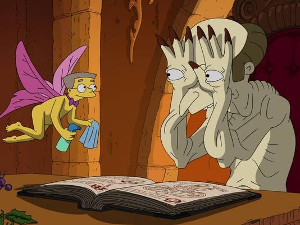
Guillermo del Toro opens the Animation Domination Halloween specials with great style.
This is a great way to kick off the most festive time of the year. Since I’m so dedicated to amazing horror content, I’ll be reviewing the Halloween episodes. All four of the shows pull out all the stops for Halloween. Who will come out on top? The smart money is on American Dad but Bob’s Burgers does really wry holiday episodes. Family Guy is totally hit or miss and The Simpsons are only as good as their worst sketch of the night.
First up is The Simpsons. This is “Treehouse of Horror XXIV,” which means only one season did not have a Halloween episode. Guillermo del Toro is tasked with the opening sequence and it’s amazing. My favorite parts are the Pan’s Labyrinth references. The sheer volume of horror references is stunning. It flows in a very logical way and ends beautifully on his most critically acclaimed dark fantasy/horror work. If nothing is this good the rest of the night, I will be satisfied.
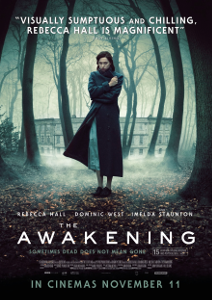 The Awakening is a haunted house film told from the perspective of a skeptic. Florence Cathcart is England’s leading paranormal investigator, debunking the schemes of spiritualists and delusions of regular people alike. In 1921, she is invited to a boarding school where the boys claim to see a ghost. A death happened on school grounds during the fall session and Cathcart is believed to be the last hope to ensure any students return for the spring.
The Awakening is a haunted house film told from the perspective of a skeptic. Florence Cathcart is England’s leading paranormal investigator, debunking the schemes of spiritualists and delusions of regular people alike. In 1921, she is invited to a boarding school where the boys claim to see a ghost. A death happened on school grounds during the fall session and Cathcart is believed to be the last hope to ensure any students return for the spring.
Writer/director Nick Murphy and screenwriter Stephen Volk hit on a pleasing combination of Gothic storytelling and 1970s/80s Hammer pictures. Everything in The Awakening doesn’t quite make sense but it doesn’t have to because it sells you on the merits of Florence Cathcart and the principle conflict before it loses meaning. The sprawling school, formerly a mansion, is filled with Victorian decadence long-forgotten by the contemporary cast members. This alone justifies the moments that don’t have logical explanations. If the characters don’t even understand where they are, why should the audience understand everything that happens?
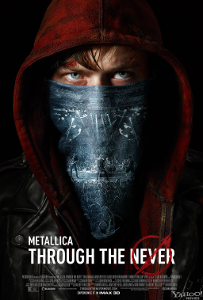 Metallica: Through the Never tries something very unusual for a modern concert film. The band members worked with writer/director Nimród Antal to develop an original story set to their set list to play out during the live concert footage. Dane DeHaan plays Trip, a young roadie sent on an important mission during the concert to retrieve an item for the band. What he wanders into is a world strewn in chaos. It’s as if the music of the band has altered reality, creating riots and nightmarish monsters on every corner. It’s an intriguing concept that breaks up the concert footage very well.
Metallica: Through the Never tries something very unusual for a modern concert film. The band members worked with writer/director Nimród Antal to develop an original story set to their set list to play out during the live concert footage. Dane DeHaan plays Trip, a young roadie sent on an important mission during the concert to retrieve an item for the band. What he wanders into is a world strewn in chaos. It’s as if the music of the band has altered reality, creating riots and nightmarish monsters on every corner. It’s an intriguing concept that breaks up the concert footage very well.
What we have here is a bit of fan service so well-executed that anyone not totally averse to the music of Metallica will find something to enjoy. I, personally, was in it for the Dan DeHaan narrative while my brother was there for the music. Everything is really well shot. The editing is solid. The 3D is clean and immersive without too many gags or distractions.
The real star of the film is the sound design. The balance between the music and the live audience is perfect. You’re allowed to experience the band’s skills within the context of the natural energy of the audience. Arena tours have notorious sound issues because the physical arenas are not designed for live music and this team recorded everything beautifully.
It continues on with the Trip’s story in the film. The sound effects added in–car crashes, explosions, police batons, etc.–sync well with the music. It’s a bit more subtle than the manipulation of levels in the pure concert scenes but it’s solid work. It would be all too easy to distract from the music or the storytelling by shifting the balance too far one direction or the other and that never happens.
What does happen is the sad realization that Trip’s story is under developed. It’s basically a long form music video punctuated by scenes of live performance from the band. The individual vignettes are good on their own. I’m quite fond of the opening sequence where Trip rides his skateboard past fans and band members prepping for the concert, as well as a rather unsettling sequence where Trip wanders through streets filled with hanged bodies. They just don’t actually add up to a satisfactory story.
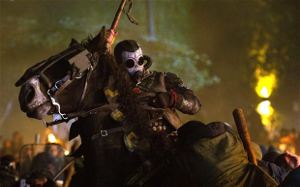
The style of Metallica: Through the Never cannot be denied
There is never an attempt after the villain’s introduction to explain what’s causing the chaos or even stick to the basic narrative conceit. It shifts, quite honestly, to a series of post-apocalyptic horror cliches and music video trends that fell out of favor in the 90s. The technical execution and, indeed, Dane DeHaan’s performance as Trip, are both excellent. It’s the story itself that becomes a bit too elusive to be satisfactory.
Metallica: Through the Never is part heavy metal concert film, part experimental musical and will probably be best appreciated in a movie theater. The sound design is so key to the experience and so delicately handled that something will inevitably be lost in all but the most advanced home theater sound systems. Anyone interested in the film should seek it out in theaters. Fans of the music will undoubtedly be pleased to see such a strong and stylish presentation of the music and performance style of Metallica.
Rating: 7/10
This review is part of 31 Days of Horror at Sketchy Details. Click through for more great horror content.
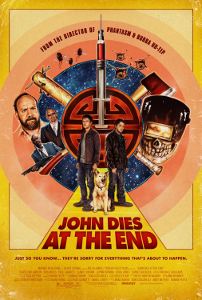 If anyone could make a sensible adaptation out of David Wong’s bizarro horror/comedy novel John Dies at the End, it would be writer/director Don Coscarelli. He gets weird. From the first two entries in the Phantasm series to the wild ride of Bubba Ho-Tep, Coscarelli has made a name for himself as a director of weird films. The quasi-Lovecraftian nightmare of Wong’s fictional blog turned novel is right in his wheelhouse. His approach just might not be what you would expect.
If anyone could make a sensible adaptation out of David Wong’s bizarro horror/comedy novel John Dies at the End, it would be writer/director Don Coscarelli. He gets weird. From the first two entries in the Phantasm series to the wild ride of Bubba Ho-Tep, Coscarelli has made a name for himself as a director of weird films. The quasi-Lovecraftian nightmare of Wong’s fictional blog turned novel is right in his wheelhouse. His approach just might not be what you would expect.
In the present, Dave is meeting with a newspaper reporter named Arnie to come clean with his story about an alternate dimension’s drug and monsters infecting our world. Dave tells Arnie the story of how he and John came to discover this disturbing alternate world that is invisible to the naked eye. Only a scant glance out of the corner of your eye can show you the horrors lurking everywhere if you do not take the Soy Sauce.
Wong’s novel is very episodic in nature. It tells three interconnected stories with the same beats and locations about Dave and John fighting against the intrusion of an alternate dimension. The reason it works is that there are humans cooperating with the alternate dimension to control the world. They basically hit the reset button, erase the evidence, and leave John and Dave to take the fall for everything.
In anticipation of season 3 of American Horror Story, I breakdown how series creators Ryan Murphy and Brad Falchuk’s everything but the kitchen sink approach to horror actually works. Watch the video, then click through for all the behind the scenes gossip.
My new Horror Thursday column is up at Man, I Love Films. This week, we’re looking at one of the least and most faithful Lovecraft adaptations to ever grace the silver screen. It’s the Schrodinger’s Cat of Lovecraft films.
Horror Thursday: The Dunwich Horror